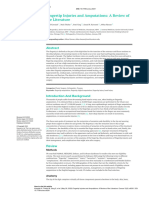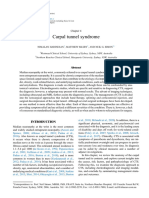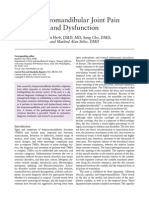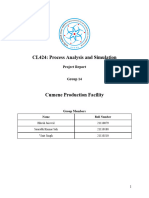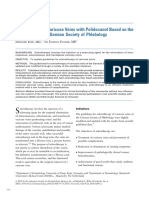Isj-9913 R
Isj-9913 R
Uploaded by
María Alejandra Jacquez GraffCopyright:
Available Formats
Isj-9913 R
Isj-9913 R
Uploaded by
María Alejandra Jacquez GraffOriginal Title
Copyright
Available Formats
Share this document
Did you find this document useful?
Is this content inappropriate?
Copyright:
Available Formats
Isj-9913 R
Isj-9913 R
Uploaded by
María Alejandra Jacquez GraffCopyright:
Available Formats
International Surgery Journal
Ricarte-Almeida ER et al. Int Surg J. 2023 Oct;10(10):1727-1731
http://www.ijsurgery.com pISSN 2349-3305 | eISSN 2349-2902
DOI: https://dx.doi.org/10.18203/2349-2902.isj20232872
Review Article
Evidence in treatment of trigger finger: a review
Ricarte-Almeida E. R.1, Ruiz-Berrones A.1, Pérez-Bravo J.2, Becerra-Pecero M.3,
Tovar-Ramírez J. A.1, Valdés-Ramos R. L.4, Mendoza-Argáez J. I.5, Jaimes-Durán E. M.6*
1
Department of General Surgery, North Central Hospital, PEMEX, Mexico
2
Department of South Central Hospital, PEMEX, Mexico
3
Department of General Surgery, Military Central Hospital, Mexico
4
Department of General Surgery, Monterrey Regional Hospital, ISSSTE, Monterrey, Mexico
5
Department of General Surgery, Dr. Fernando Quiroz Gutiérrez General Hospital, Mexico
6
Department of Plastic and Reconstructive Surgery, South Central Hospital, PEMEX, Mexico
Received: 28 August 2023
Accepted: 16 September 2023
*Correspondence:
Dr. Jaimes-Durán E. M.,
E-mail: drmichjduran.cpr@gmail.com
Copyright: © the author(s), publisher and licensee Medip Academy. This is an open-access article distributed under
the terms of the Creative Commons Attribution Non-Commercial License, which permits unrestricted non-commercial
use, distribution, and reproduction in any medium, provided the original work is properly cited.
ABSTRACT
Sclerosing flexor tenosynovitis (commonly known as “trigger finger”) is one of the main causes of pain and disability
in the hand for which patients attend reconstructive and orthopedic surgery. The pathophysiology of this affectation is
based on the presence of repetitive trauma that generates an inflammatory process in the sheath of the flexor tendon of
the fingers, which eventually generates an alteration in the hand pulley system and produces all the manifestations
characteristics of this disease. First and second author independently searched databases using the following databases:
Medline, Cinhal, Pubmed, Cochrane Library, and Clinicaltrials.gov, using the keywords: trigger finger conservative
and surgical management. Publications that evaluated the effectiveness and provided comparative and conclusive
information on the results of surgical and conservative management for carrying out this work were reviewed and
considered. The usefulness of 3 therapeutic methods for managing trigger finger was reviewed, identifying a success
rate of 56% with isolated steroid injection and up to 79.6% when used serially; in the use of orthoses, a reduction in the
symptom score was identified in all cases, although there is no conclusive evidence on long-term results and complete
resolution of the condition; Regarding surgical treatment, it was determined that it represents the best alternative for
long-term symptom resolution, with a higher rate of sequelae such as pain within the first week or nerve injury.
Intrafascial steroid-based injection represents the initial technique of choice in the management of trigger finger. The
use of orthoses may represent an alternative in patients who have no impediment for their use for a fairly long time.
Open surgical treatment continues being the therapeutic measure to be overcome, with a high symptom resolution rate
1 year after the procedure.
Keywords: Finger, Occupational hand injuries, Hand surgery, Tendon sheath
INTRODUCTION as diabetes, and occurs mainly in the dominant hand.1,2 The
main symptoms present are the functional limitation to
Sclerosing tenosynovitis (also known as ‘trigger finger’) is grasp and hold objects with handles, manipulate coins and
one of the main causes of pain and disability in the hands, perform fine movements with the fingers. TF frequently
and also one of the main reasons for consultation with the coexists with other muscle-tendon disorders of the upper
reconstructive surgeon. TF is a common hand condition extremity, such as de Quervain's tenosynovitis, lateral
that occurs in 2-3% of the population, with a higher epicondylitis, Dupuytren's contracture, or carpal tunnel
incidence in middle-aged women, with comorbidities such syndrome.3 This pathology occurs as a consequence of
International Surgery Journal | October 2023 | Vol 10 | Issue 10 Page 1727
Ricarte-Almeida ER et al. Int Surg J. 2023 Oct;10(10):1727-1731
repetitive trauma that generates a chronic inflammatory flexor tendon, altering the function of the pulley system,
process in the flexor tendon sheath of the fingers. This triggering difficulty for the tendon to pass through the
structure is responsible for keeping the deep and tunnel.5
superficial tendons in place during the movement of the
fingers, which is why its chronic inflammation generates a
long-term nodule, which will cause abnormal movement
through the tendon pulley system as it passes through it. 4
The name of the pathology as ‘trigger finger’ was acquired
from the classic ‘trigger’ toward flexion at the moment the
nodule passes under the pulley system, and it occurs more
frequently in the thumb, middle, and ring fingers. 5
Anatomy
Figure 1: Normal anatomy of the flexor sheath,
Before describing the anatomy necessary to understand the showing the pulley, tendon, and tenosynovium.
pathophysiology and surgical approach of trigger finger, it
is important to mention that what is described in this
section corresponds only to the second to fifth fingers,
since the thumb (or first finger) has their own anatomical
features. The flexor muscles of the fingers and their
corresponding sheaths are considered as a system of
pulleys. The flexor longus tendon sheaths extend from the
metacarpal heads (the distal palmar crease, which lies
superficial; the palmar lamina, which lies deep) and to the
distal phalanges. These sheaths are attached to the
underlying bones and to the volar plates, preventing the
tendons from tightening. Due to these anatomical features,
it is expected that thickenings will develop in the fibrous
flexor sheath, which act as pulleys and help direct
movements during finger gliding.6,7 Figure 2: Abnormal anatomical configuration
showing the tendon stuck in a thickened and
Two main types of pulleys have been determined in this narrowed pulley.
system, which have been called: annular (A) and crossed
(C). The former are made up of simple fibrous bands or METHODS
rings, which gives them their name. Crossed pulleys have
two fibrous bands that cross each other. All pulleys are First and second author independently searched databases
organized according to their location from proximal to using the following databases: MEDLINE, CINHAL,
distal. The A1 pulley is the most proximal and is the main PubMed, Cochrane Library, and Clinicaltrials.gov, using
one involved in the pathophysiology of TF. The A1 pulley the keywords: trigger finger conservative and surgical
overlaps the MCP joints. Later we find the A2 pulley, management. Publications that evaluated the effectiveness
which overlaps the proximal end of the proximal phalanx. and provided comparative and conclusive information on
The C1 pulley is next and overlaps the middle of the the results of surgical and conservative management for
proximal phalanx. Subsequently, the A3 pulley, which lies carrying out this work were reviewed and considered.
over the proximal interphalangeal (PIP) joint, is listed. The
C2 pulley lies over the proximal end of the middle phalanx, RESULTS
while the A4 pulley lies over the center of the middle
phalanx. The C3 pulley is located on the distal end of the Through the years, both plastic surgeons, orthopedists
middle phalanx and finally the A5 pulley is located on the specializing in hand surgery, and rheumatologists have
proximal end of the distal phalanx (Figure 1). 7,8 experimented with various alternatives for the
management of trigger finger. There are surgeons who
Pathophysiology consider surgical treatment as the treatment of choice for
this pathology; however, it is undeniable that conservative
The pathophysiology of this affectation is based on the management represents an alternative with good results for
presence of repetitive traumas that generate an a group of patients. Typically, the initial management of
inflammatory process in the sheath of the flexor tendon of TF consists of the injection of steroids, while when we talk
the fingers. This anatomical structure forms a tunnel deep about surgical management, open surgery represents the
into the hand, which holds both the deep and superficial gold standard for the treatment of this disease, however
tendons in place during the execution of movements. This there are still no conclusive studies to determine the
repeated trauma conditions the formation of a nodule in the usefulness of endoscopic surgery or percutaneous surgery
International Surgery Journal | October 2023 | Vol 10 | Issue 10 Page 1728
Ricarte-Almeida ER et al. Int Surg J. 2023 Oct;10(10):1727-1731
compared to traditional surgery. Seeking to eliminate these patients, patients with involvement of only one finger,
discrepancies and seek to standardize treatment duration of symptoms<4 months), without comorbidities
alternatives for trigger finger, in 2014 the Handguide (e. g., RA, diabetes mellitus).13-17
group published a guide for the treatment of trigger finger,
in which it determined that the most appropriate Table 1: Poor prognostic factors in steroid injection
therapeutic options for TF, are: orthosis (splinting), into the tendon sheath.13-17
corticosteroid injections, corticosteroid injections plus
brace use surgery.9 Factors
Male patients
Conservative treatment Patients with involvement of two or more fingers
Duration of symptoms>4 months
The first publications on the conservative treatment of TF Comorbidities (e. g., RA, diabetes mellitus)
considered it a prolonged, unreliable, and expensive
alternative, however subsequent series documented Orthosis
relevant adverse effects in surgical management, which
diverted the spotlight towards conservative treatment,
Lundsford et al published in 2017 a systematic review 11,
which generated lower long-term morbidity. Among the which included a total of 7 studies with 297 patients, in
alternatives for conservative management, two treatments
which the utility of the orthosis for the management of TF
stand out: steroid injection into the tendon sheath and
was evaluated. In it, the success in the management of the
orthotic treatment. TF was evaluated in patients in whom orthoses were used,
demonstrating a positive effect in reducing pain after using
Steroid injection a device, as well as a change in the stages of the TF scale
scores (Table 2).18,19
Steroid injection is considered to be the conservative
therapy with the highest and fastest success rate of non- Table 2: Green classification of trigger finger.17
surgical treatments, as well as the one that generates the
lowest cost for the patient. Classification
Grade I Palm pain and tenderness at A1 pulley
This therapy has been used in isolation, demonstrating an
Grade II Catching of digit
effectiveness in resolving symptoms of 60-70%, although
Grade III Locking of digit, passively correctable
it has also been used in combination with the use of
orthoses or preoperatively, as in the study published by Grade IV Fixed, locked digit
Kerrigan and Stanwix in 2009, in which it was concluded
that the most successful and cost-effective management Surgical treatment
strategy for TF is the algorithm of two steroid injections
before surgical intervention.10,11 Surgical treatment represents the technique of choice in
patient’s refractory to steroid therapy and orthesis. A
A systematic review published by Fleisch, et al in 2007, Cochrane review published in 2019 by Fiorini et al made
documented a 56% success rate with single steroid a comparison between isolated steroid injection verses
injection, while Lewis et al sought to document serial surgical treatment, considering two techniques: open
steroid injection, finding much more encouraging results, surgery and steroid injection into the tendon sheath. 19
with symptom remission rates of 66.3%, 79.4% and 79.6% Based on two trials including 270 participants, symptom
in the first, second and third injection, respectively. 12 resolution without recurrence was achieved in 92% of
cases with open surgery, while a 61% success rate was
Injection of steroids into the tendon sheath is a procedure observed with steroid injection. Regarding pain, which
that can be performed in an office, as long as the necessary was evaluated as its presence or absence after 7 days after
aseptic conditions are available. Several drugs have been the procedure, it was found that more people had pain with
used to do this, among them the most frequently used are open surgery verses steroid injection (33% verses 66%).
prednisolone, dexamethasone and triamcinolone, all with When analyzing trigger finger recurrence (6 to 12 months),
a good success rate and without clear superiority of one it was found that fewer people had recurrence of symptoms
over the other for the relief of symptoms. Prior localization with open surgery verses steroid injection (60% verses
of the nodule is recommended, as well as marking with 3%). New devices have been designed to try to perform a
indelible ink for better orientation prior to puncture. minimally invasive surgical approach, one of them
Likewise, the use of bupivacaine or some other anesthetic includes the ‘A-knife’ device, presented at the 10th
with a long half-life is recommended before infiltrating the Congress of the Asia-Pacific Federation of Societies of
steroid. Surgery for the Hand, it is a scalpel designed in the shape
of a scythe.20 As the same as the original technique the
Well-identified risk factors in various clinical studies for nodule is located and marking it, to later make a 2 mm
obtaining satisfactory results with steroid injection therapy incision through which the scalpel is inserted and it is
without other adjunctive treatment (Table 1) are: female possible to cut, with subsequent release of A1-pulley.
International Surgery Journal | October 2023 | Vol 10 | Issue 10 Page 1729
Ricarte-Almeida ER et al. Int Surg J. 2023 Oct;10(10):1727-1731
Although it appears to be a promising tool due to the 3. Kim HR, Lee SH. Ultrasonographic assessment of
smaller healing surface, the fact of performing the clinically diagnosed trigger fingers. Rheumatol Int.
procedure blindly could generate greater morbidity in the 2010;30(11):1455-8.
short term than that presented in open surgery. It is still a 4. Kloeters O, Ulrich DJ, Bloemsma G, Houdt CI.
tool in the evaluation period, larger cohorts are needed to Comparison of three different incision techniques in
be able to compare it versus standard therapy. A1 pulley release on scar tissue formation and
postoperative rehabilitation. Arch Orthop Trauma
DISCUSSION Surg. 2016;136(5):731-7.
5. Zyluk A, Jagielski G. Percutaneous A1 pulley release
Faced with the various alternatives that exist for the vs steroid injection for trigger digit: the results of a
management of trigger finger, treatment must be prospective, randomized trial. J Hand Surg Eur Vol.
individualized. The characteristics of each patient can 2011;36(1):53-6.
offer a range of complications and variable benefits with 6. Makkouk AH, Oetgen ME, Swigart CR, Dodds SD.
respect to each procedure. For example, in patients with Trigger finger: etiology, evaluation, and treatment.
diabetes, according to the evidence presented above, the Curr Rev Musculoskelet Med. 2008;1(2):92-6.
injection of steroids into the tendon sheath would be 7. Cardoso R, Szabo RM. Wrist anatomy and surgical
inconvenient, in which case the patients could directly approaches. Orthop Clin North Am. 2007;38(2):127-
benefit from surgical release of the flexor tendon. 48.
However, patients with a low symptom rate and no risk 8. Turowski GA, Zdankiewicz PD, Thomson JG. The
factors may be candidates for steroid injection alone or a results of surgical treatment of trigger finger. J Hand
combination steroid injection and orthosis. Surg Am. 1997;22(1):145-9.
9. Doyle JR. Anatomy of the finger flexor tendon sheath
On the other hand, regarding surgical management, the and pulley system. J Hand Surg Am. 1988;13(4):473-
indications after the administration of the steroid injection 84.
are not clearly established regarding the time or the 10. Huisstede BM, Hoogvliet P, Coert JH, Fridén J;
number of sessions, which leaves the exact time of the European HANDGUIDE Group. Multidisciplinary
surgery to be judged by the surgeon. consensus guideline for managing trigger finger:
results from the European HANDGUIDE Study.
CONCLUSION Phys Ther. 2014;94(10):1421-33.
11. Lewis J, Seidel H, Shi L, Wolf J, Strelzow J. National
Despite the fact that trigger finger is a disease that has been Benchmarks for the Efficacy of Trigger Finger and
identified and studied for many years, three well- the Risk Factors Associated With Failure. J Am Acad
established lines of treatment remain, which consist of Orthop Surg Glob Res Rev. 2023;7(2):e22.00198.
steroid injection, orthosis alone or combined with steroid 12. Kerrigan CL, Stanwix MG. Using evidence to
injection, or surgical management. All of them can offer minimize the cost of trigger finger care. J Hand Surg
good results if we individualize the management in each Am. 2009;34(6):997-1005.
patient, with strengths and weaknesses according to the 13. Fleisch SB, Spindler KP, Lee DH. Corticosteroid
parameter that we evaluate. The treatment that could be injections in the treatment of trigger finger: a level I
summarized as the one that offers the best definitive result and II systematic review. J Am Acad Orthop Surg.
is surgery, while the cheapest, fastest, least morbid and 2007;15(3):166-71.
with a good cost-benefit ratio is injection with steroids into 14. Stahl S, Kanter Y, Karnielli E. Outcome of trigger
the tendon sheath. There are novel therapies and devices finger treatment in diabetes. J Diabetes
that can reduce the sequelae of surgical management, Complications. 1997;11(5):287-90.
however there is still a lack of sufficient evidence to assess 15. Dala-Ali BM, Nakhdjevani A, Lloyd MA, Schreuder
their superiority over conventional surgical treatment. FB. The efficacy of steroid injection in the treatment
of trigger finger. Clin Orthop Surg. 2012;4(4):263-8.
Funding: No funding sources 16. Marshall S, Tardif G, Ashworth N. Local
Conflict of interest: None declared corticosteroid injection for carpal tunnel syndrome.
Ethical approval: Not required Cochrane Database Syst Rev. 2002;(4):CD001554.
17. Rozental TD, Zurakowski D, Blazar PE. Trigger
REFERENCES finger: prognostic indicators of recurrence following
corticosteroid injection. J Bone Joint Surg Am.
1. AAOS. Trigger finger. AAOS Essentials of 2008;90(8):1665-72.
Musculoskeletal Care. 6th ed. Burlington, MA: Jones 18. Baumgarten KM, Gerlach D, Boyer MI.
and Bartlett Learning; 2022. Corticosteroid injection in diabetic patients with
2. Finnoff JT, Johnson W. Upper limb pain and trigger finger. A prospective, randomized, controlled
dysfunction. Cifu DX, Eapen BC, Johns JS, double-blinded study. J Bone Joint Surg Am.
Kowalske KJ, Lew HL, Miller MA, et al, eds. 2007;89(12):2604-11.
Braddom's Physical Medicine and Rehabilitation. 6th
ed. Philadelphia: Elsevier; 2021: 715-26.
International Surgery Journal | October 2023 | Vol 10 | Issue 10 Page 1730
Ricarte-Almeida ER et al. Int Surg J. 2023 Oct;10(10):1727-1731
19. Lunsford D, Valdes K, Hengy S. Conservative 22. Anuntaseree S. The percutaneous trigger finger
management of trigger finger: A systematic review. J release scalpel - the A knife. BMC Proc.
Hand Ther. 2019;32(2):212-21. 2015;9(3):A78.
20. Froimson AI. Tenosynovitis and tennis elbow. 4th
ed. Philadelphia: Churchill Livingston; 1999. Cite this article as: Ricarte-Almeida ER, Ruiz-
21. Fiorini HJ, Tamaoki MJ, Lenza M, Gomes Dos Berrones A, Pérez-Bravo J, Becerra-Pecero M,
Santos JB, Faloppa F, Belloti JC. Surgery for trigger Tovar-Ramírez JA, Valdés-Ramos RL, et al.
finger. Cochrane Database Syst Rev. Evidence in treatment of trigger finger: a review. Int
2018;2(2):CD009860.
Surg J 2023;10:1727-31.
International Surgery Journal | October 2023 | Vol 10 | Issue 10 Page 1731
You might also like
- Carpal Tunnel Syndrome: A Review of LiteratureDocument7 pagesCarpal Tunnel Syndrome: A Review of Literatureanita putriNo ratings yet
- Inspection Checklist For Hvac (DUCT Installation) F01 & F02Document4 pagesInspection Checklist For Hvac (DUCT Installation) F01 & F02Researcher100% (2)
- Stress Management at Call CentreDocument33 pagesStress Management at Call CentreShravan kumar100% (3)
- Extensor Tendon Injuries 2010 The Journal of Hand SurgeryDocument8 pagesExtensor Tendon Injuries 2010 The Journal of Hand SurgeryProfesseur Christian DumontierNo ratings yet
- Article Review Kel 3 KompilasiDocument21 pagesArticle Review Kel 3 KompilasiFazlin KhuzaimaNo ratings yet
- Traumatic Extensor Tendon Injuries To The Hand: Clinical Anatomy, Biomechanics, and Surgical Procedure ReviewDocument11 pagesTraumatic Extensor Tendon Injuries To The Hand: Clinical Anatomy, Biomechanics, and Surgical Procedure ReviewJosua LouisNo ratings yet
- S1699258X12002422Document8 pagesS1699258X12002422oersoncalebNo ratings yet
- Clinical Review: Management and Referral For Trigger Finger/thumbDocument4 pagesClinical Review: Management and Referral For Trigger Finger/thumbRipka_uliNo ratings yet
- Finger/thumb Management and Referral For Trigger: Data Supplement ReferencesDocument5 pagesFinger/thumb Management and Referral For Trigger: Data Supplement ReferencesstreeturbanNo ratings yet
- Extensor Digitorum Tendon Ruptures of Manus DextraDocument23 pagesExtensor Digitorum Tendon Ruptures of Manus DextraSepti Dwi SUlistyowatiNo ratings yet
- Ijms 21 00844 v3Document20 pagesIjms 21 00844 v3Jose PerezNo ratings yet
- Techniques in Hand and Amp Upper ExtremiDocument6 pagesTechniques in Hand and Amp Upper ExtremiSotiris PlakoutsisNo ratings yet
- Transposition of EIP Pro EPL ACTA BIOMED 2019 Sperati - CeriDocument4 pagesTransposition of EIP Pro EPL ACTA BIOMED 2019 Sperati - CerivasasdfwqeNo ratings yet
- Mallet Finger Suturing TechniqueDocument5 pagesMallet Finger Suturing TechniqueSivaprasath JaganathanNo ratings yet
- Cuadricepsplastia MipiDocument5 pagesCuadricepsplastia MipiVictor HernandezNo ratings yet
- Tendon TransfersDocument194 pagesTendon Transferschinthaka_wijedasa100% (4)
- First Dorsal Metacarpal Artery Flap For Thumb Reconstruction: A Retrospective Clinical StudyDocument7 pagesFirst Dorsal Metacarpal Artery Flap For Thumb Reconstruction: A Retrospective Clinical StudyAry YounusNo ratings yet
- 1172 5537 1 PBDocument6 pages1172 5537 1 PBAdelina SendreaNo ratings yet
- 2007 Article 9012Document5 pages2007 Article 9012Karen PinemNo ratings yet
- PRM2020 6965381Document9 pagesPRM2020 6965381zoreNo ratings yet
- Fingertip Injuries and Amputations A Review of 2020Document6 pagesFingertip Injuries and Amputations A Review of 2020Oscar Cayetano Herrera RodríguezNo ratings yet
- JAAOS - Volume 02 - Issue 01 January 1994Document67 pagesJAAOS - Volume 02 - Issue 01 January 1994kenthepaNo ratings yet
- ManuscriptDocument15 pagesManuscriptsheshagiri vNo ratings yet
- Extensor Apparatus - AOFAS (Dalmau-Pastor)Document13 pagesExtensor Apparatus - AOFAS (Dalmau-Pastor)lukejones_85No ratings yet
- Tendon TransfersDocument194 pagesTendon TransferscesarNo ratings yet
- The Forearm, Wrist and HandDocument20 pagesThe Forearm, Wrist and HandKatalinNo ratings yet
- JAAOS - Volume 21 - Issue 10 October 2013 PDFDocument67 pagesJAAOS - Volume 21 - Issue 10 October 2013 PDFkenthepaNo ratings yet
- DpGKNBDryneedling 19-23Document6 pagesDpGKNBDryneedling 19-23Lia YuanitaNo ratings yet
- Results of Surgical TreatmentDocument4 pagesResults of Surgical TreatmentChristine Yohana SianturiNo ratings yet
- A Proximal Interphalangeal JointDocument6 pagesA Proximal Interphalangeal JointMaria Clara SalgadoNo ratings yet
- Hand and Wrist Injuries: Part I. Nonemergent EvaluationDocument8 pagesHand and Wrist Injuries: Part I. Nonemergent EvaluationMayara de OliveiraNo ratings yet
- Klumpke's ParalysisDocument20 pagesKlumpke's ParalysisRajath Kumar K R KNo ratings yet
- Usg Muskuloskel in Oa Hand 2016Document3 pagesUsg Muskuloskel in Oa Hand 2016wahyu_sitaNo ratings yet
- Comparison of The Repair Techniques For Extensor Tendon Injuries in The HandDocument6 pagesComparison of The Repair Techniques For Extensor Tendon Injuries in The HandInternational Journal of Innovative Science and Research TechnologyNo ratings yet
- Flexor Tendon Sheath InfectionsDocument10 pagesFlexor Tendon Sheath InfectionskenthepaNo ratings yet
- Ecr2010 C-2353Document37 pagesEcr2010 C-2353SaraNo ratings yet
- Distally BasedsuperficialDocument7 pagesDistally BasedsuperficialyennysabriniNo ratings yet
- Carpal Tunnel SyndromeDocument28 pagesCarpal Tunnel Syndromems bsNo ratings yet
- Principles of Hand Fracture ManagementDocument22 pagesPrinciples of Hand Fracture ManagementjodyhernantoNo ratings yet
- Anatomical Arthroscopic Graft Reconstruction of The Anterior Tibiofibular Ligament For Chronic Disruption of The Distal SyndesmosisDocument5 pagesAnatomical Arthroscopic Graft Reconstruction of The Anterior Tibiofibular Ligament For Chronic Disruption of The Distal SyndesmosisMoustafa MohamedNo ratings yet
- ArthrocentesisDocument10 pagesArthrocentesisPranave PNo ratings yet
- Thomopoulos 2015Document28 pagesThomopoulos 2015Carol DiasNo ratings yet
- Physicalexaminationofthehand WeinzwegDocument10 pagesPhysicalexaminationofthehand WeinzwegareskaramadhanNo ratings yet
- PIIS2212628721001900Document6 pagesPIIS2212628721001900ANDRES DURANNo ratings yet
- Trigger FingerDocument6 pagesTrigger FingerandreidviddNo ratings yet
- Tenosynovitis Tendons Thumb Swiss Surgeon Fritz de Quervain de Quervain's ThyroiditisDocument4 pagesTenosynovitis Tendons Thumb Swiss Surgeon Fritz de Quervain de Quervain's ThyroiditisFelisitas NasirNo ratings yet
- Oroaj MS Id 555591 PDFDocument6 pagesOroaj MS Id 555591 PDFSanket SawantNo ratings yet
- EBM Fingertip Reconstruction JHS2006Document3 pagesEBM Fingertip Reconstruction JHS2006Professeur Christian DumontierNo ratings yet
- Elbow DislocationsDocument5 pagesElbow DislocationsAdu-danquah StephenNo ratings yet
- Temporomandibular Joint Pain and DysfunctionDocument7 pagesTemporomandibular Joint Pain and DysfunctionAfroyCrusherNo ratings yet
- Understanding Carpal Tunnel Syndrome.4Document8 pagesUnderstanding Carpal Tunnel Syndrome.4ayu permata dewiNo ratings yet
- Terapia. de ManoDocument10 pagesTerapia. de ManoAgustina DavalosNo ratings yet
- Tendon Transfers For Thumb Opposition: Alexander Y. Shin, MD, and Khiem D. Dao, MDDocument17 pagesTendon Transfers For Thumb Opposition: Alexander Y. Shin, MD, and Khiem D. Dao, MDFernando Martín Arce AlvaNo ratings yet
- Efficacy of Extracorporeal Shockwave Therapy in The Treatment of Patients With Trigger FingerDocument6 pagesEfficacy of Extracorporeal Shockwave Therapy in The Treatment of Patients With Trigger FingerInternational Journal of Innovative Science and Research TechnologyNo ratings yet
- Posttraumatic Boutonniere and Swan Neck Deformities Mckeon2015Document10 pagesPosttraumatic Boutonniere and Swan Neck Deformities Mckeon2015yerec51683No ratings yet
- Medip, IJORO-2331 ODocument7 pagesMedip, IJORO-2331 Oprashant makadiaNo ratings yet
- 1 s2.0 S1743919106600538 Main PDFDocument3 pages1 s2.0 S1743919106600538 Main PDFTarun MathurNo ratings yet
- Finger ContractureDocument29 pagesFinger ContractureRosita AlifaNo ratings yet
- Restoration of Thumb Opposition OpponensplastyDocument7 pagesRestoration of Thumb Opposition Opponensplasty_clau_No ratings yet
- Epidemiologia de Lesiones de Punta de Dedo en Hospital de PEMEXDocument14 pagesEpidemiologia de Lesiones de Punta de Dedo en Hospital de PEMEXOscar Cayetano Herrera RodríguezNo ratings yet
- Dislocation of the Temporomandibular Joint: A Guide to Diagnosis and ManagementFrom EverandDislocation of the Temporomandibular Joint: A Guide to Diagnosis and ManagementNigel Shaun MatthewsNo ratings yet
- Method Statement For Hydro-Vacuum Excavation (HYDRO-VAC)Document16 pagesMethod Statement For Hydro-Vacuum Excavation (HYDRO-VAC)hawzhinazad19899No ratings yet
- Boehm 1Document10 pagesBoehm 1Yolanda Priscilia GustantiaNo ratings yet
- AC 2 Philips FoodDocument2 pagesAC 2 Philips Foodbikramjit kunduNo ratings yet
- Aspen Flowsheet For Cumene ProductionDocument10 pagesAspen Flowsheet For Cumene ProductionSaurabh SaraffNo ratings yet
- LiptonDocument7 pagesLiptonAmna Hassan100% (1)
- Loney VS People, 2006Document2 pagesLoney VS People, 2006Daniel GalzoteNo ratings yet
- International Classification of Diseases: Presented By: DR Arijit Kundu Guided By: Prof. Sumitra PattanaikDocument56 pagesInternational Classification of Diseases: Presented By: DR Arijit Kundu Guided By: Prof. Sumitra PattanaikpriyagerardNo ratings yet
- QS Rovabio® Advance L2 - APAC ONLY (En)Document3 pagesQS Rovabio® Advance L2 - APAC ONLY (En)embahNo ratings yet
- Safety Data Sheet Sonagel D1Document14 pagesSafety Data Sheet Sonagel D1Thomas SchotsNo ratings yet
- Main Organic Acid Distribution of Authentic Citrus Juices in Turkey (#138557) - 119982Document5 pagesMain Organic Acid Distribution of Authentic Citrus Juices in Turkey (#138557) - 119982Ben WunderNo ratings yet
- Lehmann Et Al. 2006Document25 pagesLehmann Et Al. 2006João MadeiraNo ratings yet
- ISAMDocument52 pagesISAMGraciela A JuárezNo ratings yet
- Extreme Power in A Compact DesignDocument5 pagesExtreme Power in A Compact Design9867989055No ratings yet
- Stern SSH Catalogo Serie Handpumps Completo - 1 - OriginalDocument6 pagesStern SSH Catalogo Serie Handpumps Completo - 1 - OriginalEbrahim AhmariNo ratings yet
- Implications For Participating in StrikeDocument45 pagesImplications For Participating in StrikezaneleNo ratings yet
- Guide To Preparing HSE Plans and Bridging Documents - Supplement To Report 423 (2018 FEB)Document12 pagesGuide To Preparing HSE Plans and Bridging Documents - Supplement To Report 423 (2018 FEB)Htoo Htoo KyawNo ratings yet
- Sclerotherapy German GuidelinesDocument8 pagesSclerotherapy German GuidelinesGabriela DrăgoiNo ratings yet
- Diccionario EspaÑol InglÉsDocument726 pagesDiccionario EspaÑol InglÉservin-i-van9732100% (9)
- Features: 40A Drmos Power Module With Integrated Diode Emulation and Thermal Warning OutputDocument15 pagesFeatures: 40A Drmos Power Module With Integrated Diode Emulation and Thermal Warning OutputantoniocljNo ratings yet
- Teabag Process TestDocument5 pagesTeabag Process TestJonny LizardiNo ratings yet
- Daily IRA Sheet Dte & Bin WiseDocument32 pagesDaily IRA Sheet Dte & Bin WiseSumera AliNo ratings yet
- PR 2 GroupDocument33 pagesPR 2 GroupElaine DeriloNo ratings yet
- Withrop Newsletter PD DayDocument8 pagesWithrop Newsletter PD Dayapi-208242650No ratings yet
- List of Aws Security Labs by Pwnedlabs 1728618372Document7 pagesList of Aws Security Labs by Pwnedlabs 1728618372yrnx5r2zs7No ratings yet
- Revision 2 Take My Advice MDocument2 pagesRevision 2 Take My Advice MEssam TammamNo ratings yet
- 555-Timer AStable and MonostableDocument13 pages555-Timer AStable and MonostableenzuekNo ratings yet
- Cot-Science OctoberDocument4 pagesCot-Science OctoberMARJORIE PAGURAYANNo ratings yet
- AG-01 CAD SymbolsDocument8 pagesAG-01 CAD SymbolsAsan DoganNo ratings yet




















